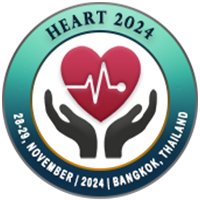
Uroosa Amin
Ziauddin University, PakistanTitle: The Effect of High Intensity Interval Training in Reducing the Risk of Cardiovascular Diseases in Obese Type-I Individuals
Abstract
Background:
This study aimed to investigate the potential of High-Intensity Interval Training (HIIT) as a non-pharmacological intervention to reduce the risk of cardiovascular disease in a
specific population.
Methods:
A quasi-experimental design was employed; involving 20 young adults aged 25-30
recruited from a fitness center. The participants underwent an 8-week high-intensity exercise
program consisting of 3 weekly sessions. Baseline measurements of body mass, height, BMI,
cholesterol, triglycerides, LDL, and HDL levels were taken before the intervention. Post-intervention measurements were obtained at the end of the 8 weeks.
Results:
The results demonstrated significant improvements in various parameters following the 8-week
workout program. BMI decreased from 32.2±1.42 to 31.67±1.45, while cholesterol levels
decreased from 221.37±9.3 to 201±9.64, indicating a reduction in total cholesterol. Triglyceride
levels decreased from 181.5±10.98 to 170.1±11.93. LDL values decreased from 144.5±8.9 to
134.2±8.13, indicating a decrease in low-density lipoprotein. Additionally, HDL levels increased
from 36.53±4.53 to 46±5.44, reflecting an increase in high-density lipoprotein levels. All these
changes were statistically significant (p≤0.005).
Conclusion:
The findings suggest that HIIT is an efficient and effective exercise for sedentary and
inactive young males. The study supports using HIIT as a non-pharmacological approach
to improve physical well-being, enhance fitness, and reduce the risk of cardiovascular
diseases. HIIT provides a time-cost-efficient alternative for individuals with limited exercise
time who still desire optimal health and fitness outcomes
Biography
To be updated soon...

